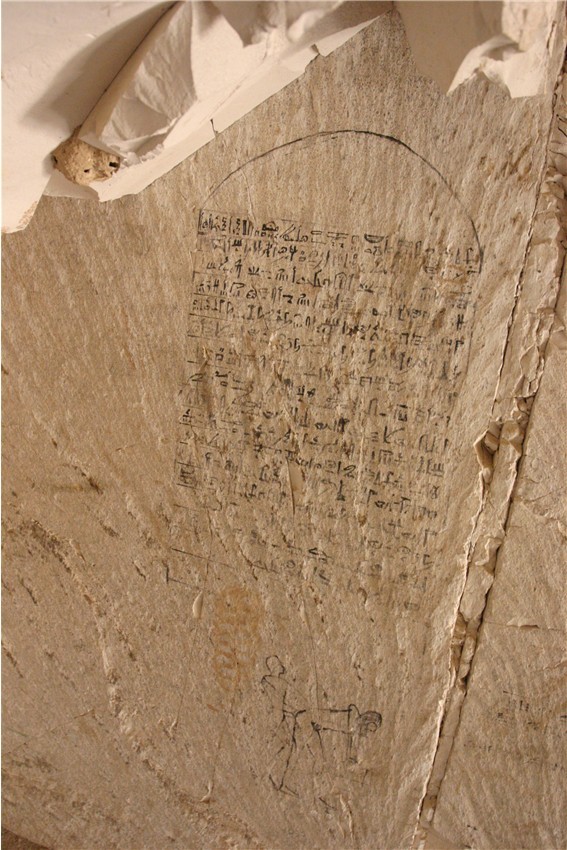 |
Neferhotep |
last update:
28.02.2009
|
Historical Data
| Name |
Title |
|
Origin |
Tomb |
Neferhotep
Nfr-Htp |
Scribe |
|
Elkab |
none known |
| Parents |
|
|
|
|
| Father: Reneny |
Mayor of Necheb (= Elkab) |
|
Elkab |
Elkab, tomb no. 7 |
| Mother: Nehi |
|
|
Elkab |
Elkab, tomb no. 7 |
| Brother(s): |
|
|
|
|
| he is depicted together with brothers in the tomb of his
parents |
|
|
|
|
| Sister(s): |
|
|
|
|
| none known |
|
|
|
|
| The writer in the temple Djeser djeseru, Neferhotep, is
known merely by a hieratic graffito. This graffito in the form of a
stele is inscribed in a grotto located above the temple of
Hatschepsut. The grotto is the most western chamber in a row of tomb
chapels from the 11th dynasty (Wente, in 1984; in addition see also
Porter&Moss, Vol. I-2, p. 658, graffiti in Deir el-Bahari where
the grotto is referred as tomb no. 504). The chamber is incomplete and
obviously served in the New Kingdom as a chapel for officials and
priests of the neighboring temples, because apart from the graffito of
Neferhotep numerous other graffiti are found (e.g., that of the Nebwa,
writer in the funerary temple of Thutmosis I.). |
|
However, the grotto did not excite attention because of the inscription of
Neferhotep but because of some neighboring erotic graffiti which are
associated with Hatshepsut.
|
|
The text of the graffito of Neferhotep was published and was translated
several times (e.g., Marciniak, in 1981, Wente, in 1984). Photos of the graffito
and the neighboring erotic scenes are published by Romer (1982; see below)
and Manley (2003; photo from N. Strudwick).
|
|
According to the text (see below the translation by Wente, 1984)
Neferhotep was writer in the temple of Hatshepsut and descended from a
respectable family from Elkab. The father Renenj, mayor of Elkab,
and the mother, the lady of the house, Nehi, can be find again in the tomb
No. 7 at Elkab. The tomb at Elkab dates back into the reign of Amenhotep
I.
|
| The text which was written with black ink is to be read
as (the numbers in clips quote the corresponding line of the text;
rectangular clips mark damaged passages):
(1) A boon which the king gives [to] Amun-Re, Lord of the Thrones of the
Two Lands, Re-Harachti, Hathor, Chieftainess of Thebes,
(2) Mut, Lady of Asheru, Nechbet, the White One of Hierakonpolis, Sachmet, Wadjit, Ptah-Sokar,
(3) Tjenenet, Anubis, foremost of the divine booth, Osiris Chontamenti
(4) who is in (every) abode of his, lord of Abydos, Wennenefer,
preeminent in Heseret, and gods, who are in
(5) the necropolis; they may grant all that is issued from their offering
tables: (namely) a thousands of bread, a thousands of [ointments], a
thousands of [incense],
(6) a thousands of [clothing], a thousands of [beer], a thousands of oxen,
a thousands of fowl, and a thousands of all things good and pure,
upon which
(7) gods live; that the sky gives; the earth creates and the inundation
bringsl
(8) from its source; for the ka of the scribe Neferhotep, who
reckons work in Djeser Djeseru. He says:
(9) Oh, every scribe, every wab-priest, every prophet, and all mortuary
priests who shall read aloud from this stele,
(10) your gods shall favor you and you shall transmit your offices to your
children
(11) according as you say:]
A boon which the king gives [to] Amun-Re, Lord of the Thrones of the Two
Lands,, Re-Harachti,
(12) Thot, lord of sacred writing, Shesemet, lady of [...], Osiris Chontamenti,
(13) the great god, lord of Abydos, Anubis, foremost of the divine booth,
and Nekhbet, the White One of Hierakonpolis; they may grant
(14) a thousands of all things good and pure upon which the gods live for
the ka of the scribe
(15) Neferhotep [justified] with Osiris, begotten by the mayor of Necheb (= Elkab) Renenj
and born of
(16) the lady of the house, Nehi, justified with Osiris.
|

|
Above a photo of the east wall of the grotto showing the graffito of Neferhotep on the left, below it a couple performing the coitus "a
tergo", right of this stela (not shown), two males are depicted, the smaller one
far right presenting an oversized erected phallus. Above the male in the center
another stele-like inscription was planned but not finished.
|
|
